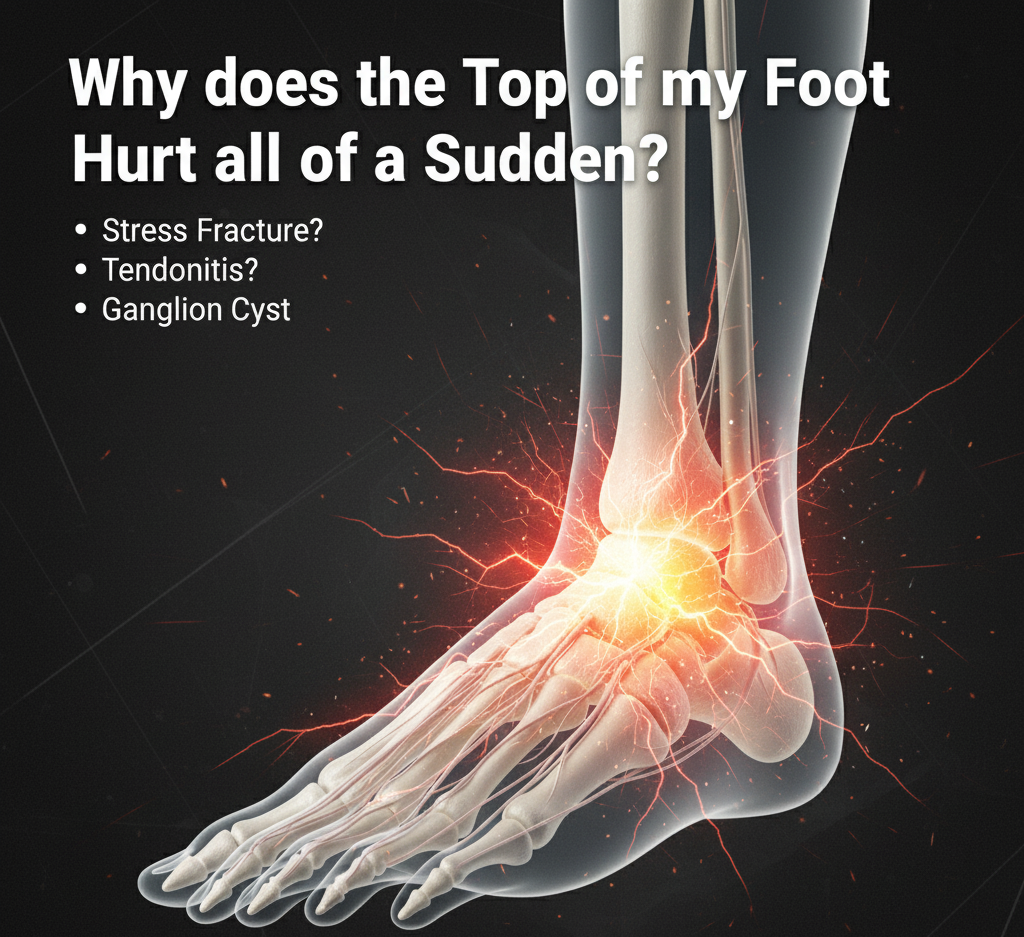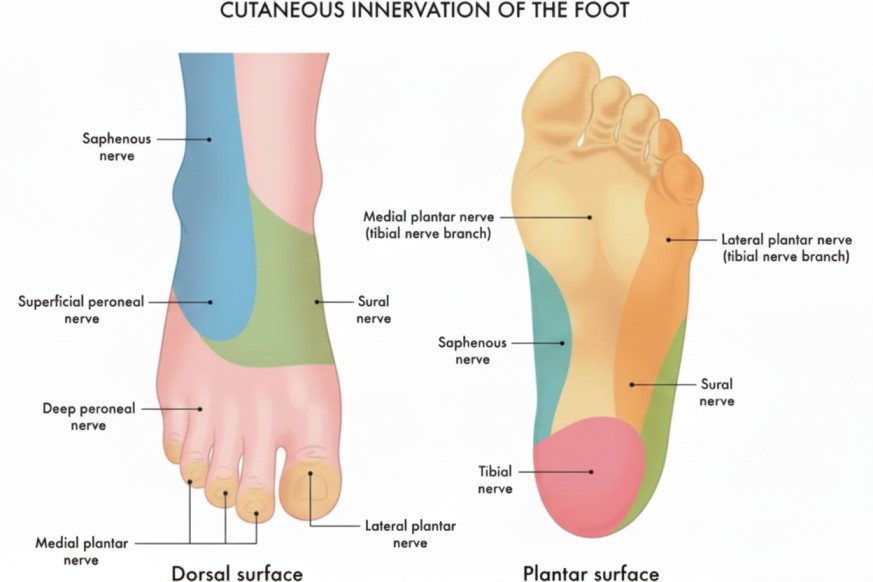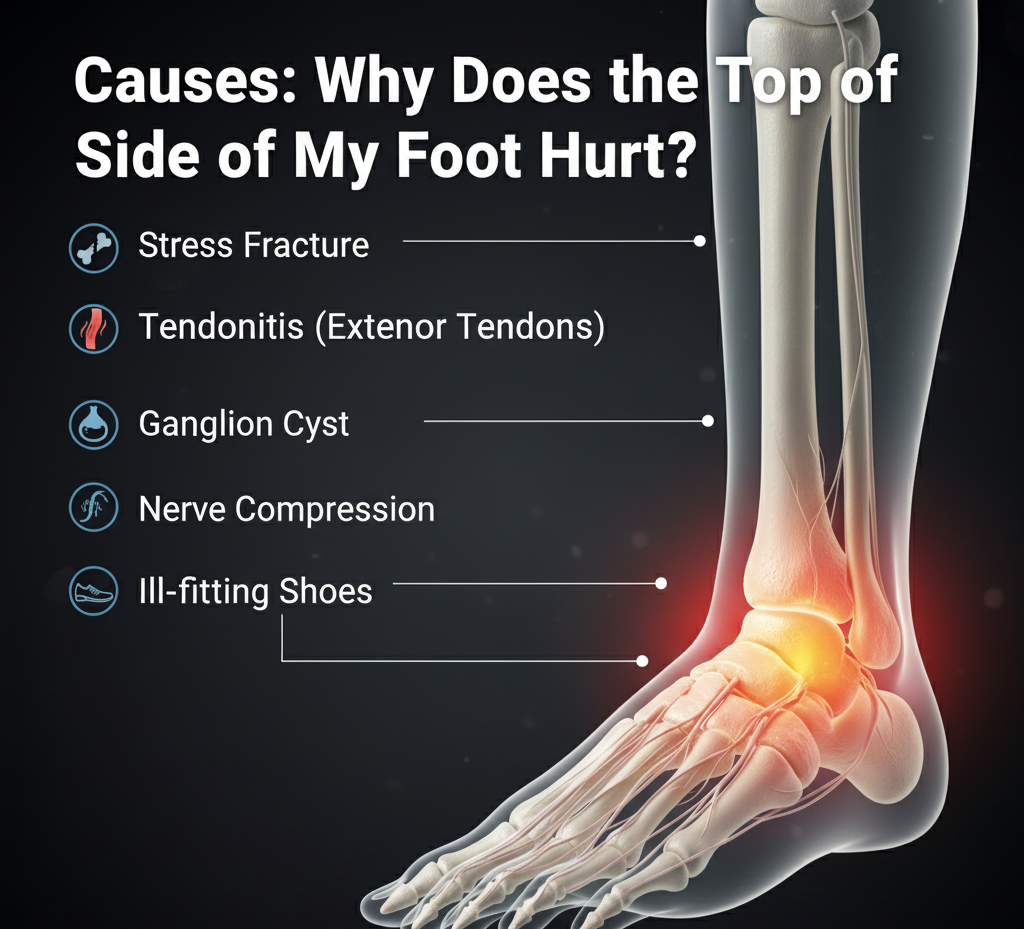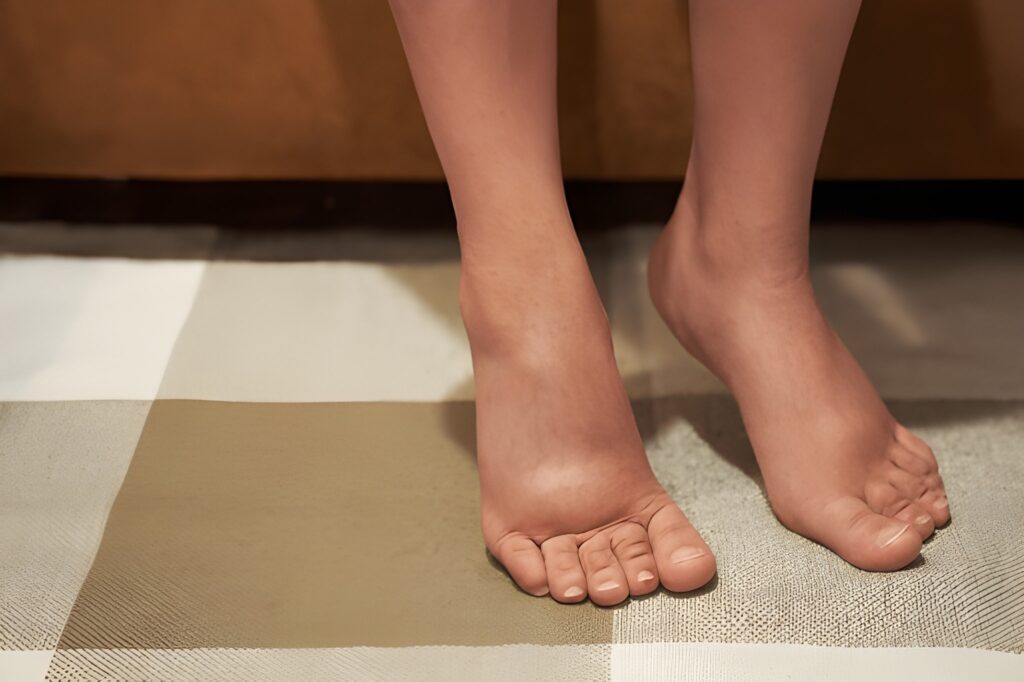Why does the Top of my Foot Hurt all of a Sudden?
Sudden Foot Pain? Discover Why the Top of Your Foot Hurts!
Foot pain can be frustrating and discomforting, especially when it appears out of nowhere and disrupts your daily activities. One common complaint patients share is pain on the top of the foot, also known as pain on the dorsal surface of the foot. You may encounter soreness, tenderness, or even sharp pain when walking, making simple movements more difficult than expected.
If you’re asking yourself, “Why does the top of my foot hurt all of a sudden?”, you’re not alone. Let’s explore the possible causes, associated symptoms, and when to see a specialist like Dr. Hesham Al Khateeb for proper evaluation and treatment.

A Quick Look at Foot Anatomy: The Dorsal Surface

To understand why the top of your foot hurts, it helps to know a bit about its anatomy. The dorsal surface of the foot refers to the top side.
This area is made up of:
- Bones: The metatarsal bones form the framework and connect to the toes.
- Tendons and ligaments: These structures help with movement and stability.
- Nerves and blood vessels: Vital for sensation and circulation.
- Soft tissues: Protect and cushion the bones and tendons.
Because so many moving parts are packed into a relatively small area, the dorsal surface is vulnerable to stress, injury, and inflammation.
What symptoms should you notice?
Experiencing pain in the top of my foot or foot pain on top can feel different depending on the cause:
Top of foot swollen or top of foot sore to touch
Discomfort walking—pain on top of foot when walking, top of foot hurts when walking
Sharp pain on top of foot or pain across top of foot
Dull ache on top of foot, top of foot throbbing, constant pain top of foot
Top of foot tender, pain and swelling
Pain in toes and top of foot, pain on top of foot near ankle, or pain on top of foot near toes
Top of foot pain without injury, either suddenly or chronically
Some Symptom-Related FAQs
Sudden pain can result from injury, swelling, stress fractures, or tendon irritation.
Walking puts pressure on bones and tendons, making injuries or inflammation more painful.
It may be due to tendonitis, tight footwear, or minor trauma.
Pain while walking is often linked to overuse, poor shoes, or joint and tendon problems.
Midfoot pain may come from ligament strain, arthritis, or a stress fracture.
Side pain often points to tendon strain, ligament injury, or ill-fitting shoes.
This can be caused by ankle sprains, stress fractures, or overuse injuries.
Bottom foot pain is commonly due to plantar fasciitis, flat feet, or nerve irritation.
It usually comes from overuse, poor arch support, or inflammation of the plantar fascia.
Causes: Why Does the Top Side of My Foot Hurt?
Recognizing what causes pain in the top of the foot helps in choosing the right care:
Injury and Swelling: Minor trauma, repetitive movements, or a direct hit can injure the bone on top of foot, tendons, or soft tissue, causing top of foot pain without injury to become apparent after some time.
Stress Fractures: Repeated impact, like running, walking long distances, or wearing poor shoes, might lead to metatarsal pain top of foot or chronic top of foot pain.
Tendonitis Top of Foot: This inflammation flares up from overuse, improper footwear, or biomechanical issues, often presenting as top of foot sore to touch and pain when moving.

-
Nerve Compression: Shoes that are too tight, injuries, or structural problems might pinch nerves on the dorsal surface of foot, triggering burning, tingling, or sharp pain on top of foot suddenly.
-
Arthritis or Inflammatory Conditions: Osteoarthritis, gout, or other joint issues can cause top of foot throbbing, swelling, and stiffness—especially when walking or standing.
-
Medical Causes: Conditions like diabetes, poor circulation, or infection can cause pain and swelling on top of foot, sometimes top of foot pain without injury.
Some Causes-Related FAQs
This is often linked to tendonitis, stress fractures, or nerve irritation.
It can occur due to arthritis, tendon inflammation, or footwear that compresses the area.
It’s inflammation of the tendons across the dorsal surface, leading to soreness and swelling.
It may suggest a stress fracture, arthritis, or bone spur.
This refers to discomfort in the long bones of the foot, often caused by overuse or improper footwear.
Common causes include tendonitis, fractures, arthritis, or compressed nerves.
Repetitive strain, swelling, or joint problems can trigger this type of pain.
Foot pain can stem from injury, inflammation, poor biomechanics, or medical conditions like arthritis.
Injury and Swelling: What you should know?
When the top of your foot hurts when walking or you notice swelling, it’s important to consider the cause:
- Acute injury: Often leads to sudden swelling, bruising, and tenderness.
- Overuse injury: Symptoms may build up gradually and worsen with activity.
- Inflammatory conditions: Swelling may come with warmth, redness, or stiffness.
If the swelling doesn’t subside with rest, ice, compression, and elevation (RICE), or if the pain feels sharp and persistent, it’s best to seek medical advice.

Nerve Compression: Shoes that are too tight, injuries, or structural problems might pinch nerves on the dorsal surface of foot, triggering burning, tingling, or sharp pain on top of foot suddenly.
Arthritis or Inflammatory Conditions: Osteoarthritis, gout, or other joint issues can cause top of foot throbbing, swelling, and stiffness—especially when walking or standing.
Medical Causes: Conditions like diabetes, poor circulation, or infection can cause pain and swelling on top of foot, sometimes top of foot pain without injury.
When to see a specialist?
While some cases of foot pain improve with rest and proper footwear, others need professional evaluation.
Consult a specialist like Dr. Hesham Al Khateeb if you notice:
- Severe or sharp pain on the top of the foot
- Persistent swelling that doesn’t go away
- Difficulty walking or bearing weight
- Visible deformity or bruising after an injury
- Recurrent pain that interferes with daily activities
Early diagnosis ensures the right treatment, whether that’s conservative care like rest and physiotherapy or more advanced medical interventions.
Treatment: How Is Pain on Top of Foot Managed?
Non-Surgical Treatments for Top-of-Foot Pain
Most cases of pain on the dorsal surface of the foot can be managed without surgery, especially when diagnosed early.
Some of the common conservative options include:
- Rest and Activity Modification: Reducing high-impact activities like running or jumping allows inflamed tissues to heal. Switching to low-impact exercises such as swimming or cycling may help maintain fitness without straining the foot.
- Ice Therapy: Applying ice packs several times a day helps reduce swelling, tenderness, and sharp pain across the top of the foot.
- Medications: Over-the-counter anti-inflammatory drugs can ease discomfort and bring down inflammation. For persistent pain, a doctor may prescribe stronger medication.
- Footwear Adjustments: Tight or unsupportive shoes are a frequent cause of top-of-foot pain. Wearing shoes with proper cushioning, wider toe boxes, and arch support can relieve pressure on the dorsal surface.
- Orthotics and Bracing: Custom shoe inserts or braces redistribute pressure across the foot and provide better alignment, especially in conditions like arthritis, tendonitis, or flat feet.
- Physical Therapy: Stretching and strengthening exercises guided by a specialist can restore flexibility and stability, while techniques like ultrasound or electrical stimulation promote healing.
- Injections: In cases of extreme inflammation, corticosteroid injections may be administered to reduce pain and swelling around tendons or joints.
Surgical Treatments for Top-of-Foot Pain
When non-surgical care does not provide relief or when there is a structural problem such as a fracture, severe arthritis, or nerve entrapment, surgical options may be considered. Under the care of a specialist like Dr. Hesham Al Khateeb, surgery is carefully recommended based on the underlying cause.
Fracture Fixation
For complex or displaced fractures of the metatarsal bones, surgical stabilization with screws, plates, or pins may be needed to restore alignment and function.
Tendon Repair or Release
In cases of chronic tendon injury or severe tendonitis unresponsive to conservative care, surgery may involve repairing or releasing the affected tendon to relieve tension and restore movement.
Nerve Decompression
If nerve entrapment is causing persistent burning or sharp pain on the top of the foot, decompression surgery may be performed to release pressure and improve nerve function.
Arthrodesis (Joint Fusion)
For advanced arthritis in the midfoot joints, fusion surgery may be done to eliminate painful movement and provide long-term stability.
Removal of Bone Spurs or Cysts
If abnormal growths are irritating soft tissues or compressing nerves, surgical removal can alleviate pain and improve comfort when walking.
Recovery after surgery usually involves a combination of rest, protected weight-bearing with crutches or a walking boot, and structured rehabilitation to regain mobility and strength.
Caring for Your Feet
Your feet are essential to your mobility, so never ignore sudden pain.
Here are some quick tips for prevention and care:
- Wear supportive, well-fitted shoes.
- Stretch and strengthen your feet and ankles.
- Rest after high-impact activity to avoid overuse injuries.
Seeking prompt evaluation for any persistent pain (especially pain and swelling on top of foot, pain in toes and top of foot, or symptoms that interfere with walking)
Get Answers on ‘why does the top of my foot hurt’ from the Expert directly - Dr. Hesham Al Khateeb
The answer to the above question could range from a simple strain to a more serious condition like a stress fracture or tendonitis. Paying attention to symptoms, such as a top of foot swollen, sore to touch, hurts when walking, or sharp pain on top of foot, is key to understanding the cause.
Dr. Hesham Al Khateeb specializes in diagnosing and treating foot conditions with an expert, patient-centered approach. If you’re experiencing persistent pain, seeking timely care can help you get back on your feet, literally, without long-term complications.

